
Labor Scarcity Society
Call it "scarcity" instead of "shortage"
Call it "scarcity" instead of "shortage"
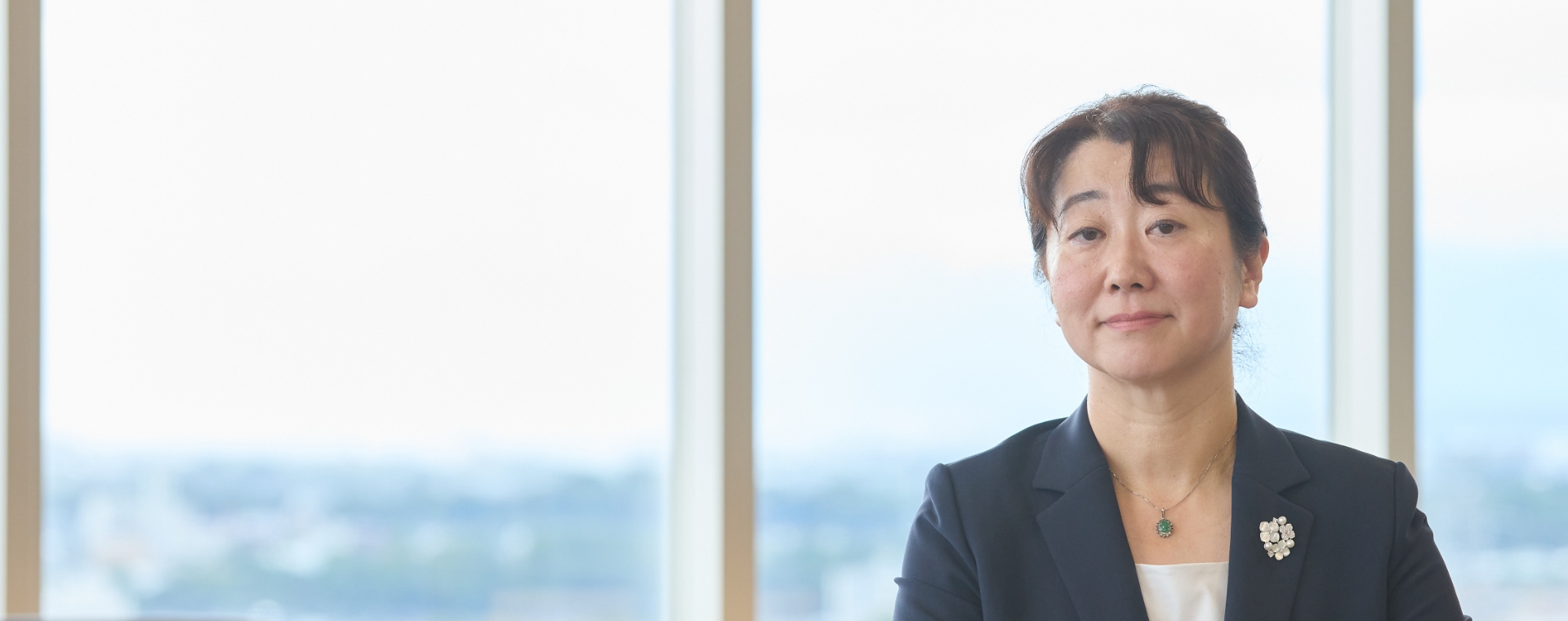
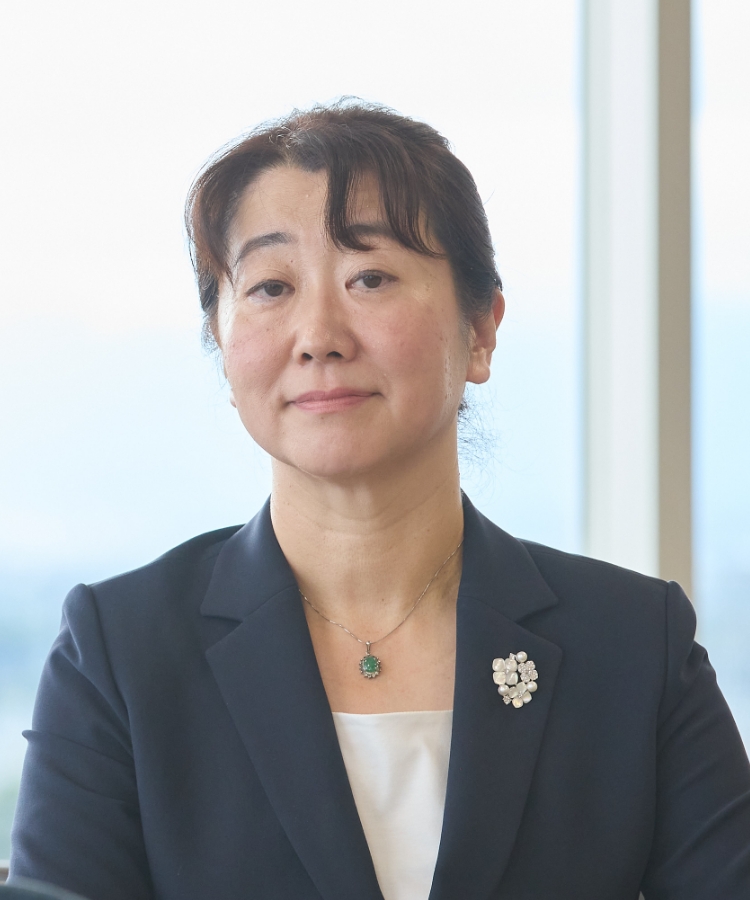
#Asia University research
KENJOH Eiko Professor
Faculty of Economics Department of Economics
2023.12.01
In the series "If it's not interesting, it's not academia!", we introduce research content and anecdotes of Asia University faculty members. The fourth installment features Professor KENJOH Eiko, Department Faculty of Economics, Faculty Department of Economics.
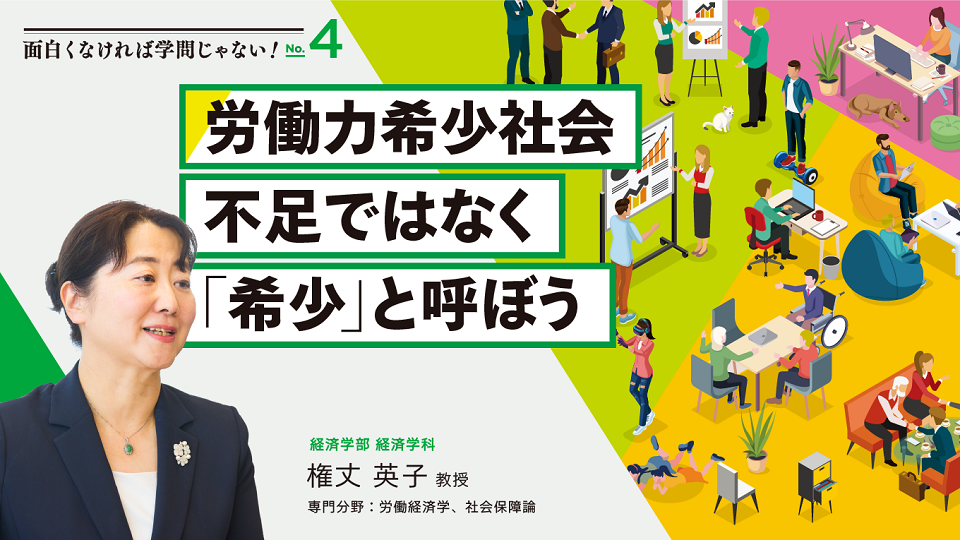
What is a labor scarcity society?
However, a problem that has continued in this country for over 20 years is that wages have not increased. This is mainly due to the fact that companies have been able to secure the labor force they need without raising wages. It is true that the productive-age population aged 15-64 has decreased by nearly 13 million people between 1995 and 2022. This is equivalent to about 20% of the number of employed people in 1995. However, the number of employed people, including elderly people and women, who traditionally did not work much, has increased, and the overall number of employed people has actually increased during this period. Much of the increased labor force is in so-called non-regular employment, working for low wages.
And now, the employment rate of women in Japan is high enough to compare favorably with other developed countries. In addition, the number of people in the so-called early elderly age group, between 65 and 74 years old, has just started to decrease. We are reaching the limit of how much we can increase the number of employed people. In other words, we are now at a turning point where a society that was once abundant in labor is finally becoming one where labor is scarce.
What will happen to our lives?
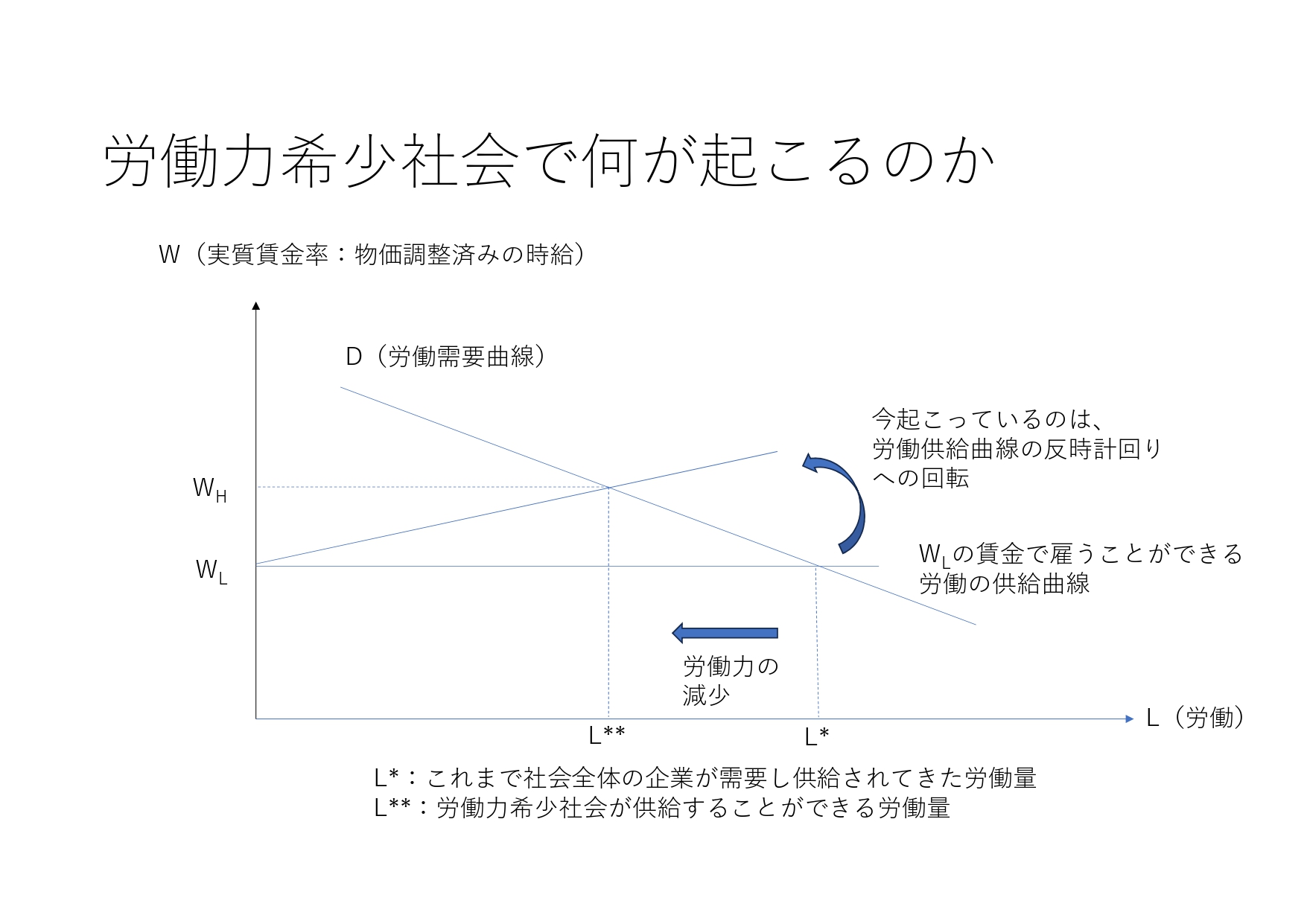 Source: Created by Professor KENJOH Eiko
Source: Created by Professor KENJOH EikoWhat will happen then? Companies will have to pay higher wages and offer more attractive working conditions to hire people. It would not be wrong to call this phenomenon a labor shortage, but I call it the arrival of a labor scarcity society.
Historically, policies to make it easier to work have been expanded whenever there was a growing sense of labor shortage. This is not limited to Japan. For example, during World War I and World War II, women also entered the workforce in Europe and the United States as men were drafted into the military. The same is true when there was a labor shortage during an economic boom. Policies to encourage women to work were often implemented during such times.
Work style reform is
Paradigm shift to a labor-scarce society
Paradigm shift to a labor-scarce society
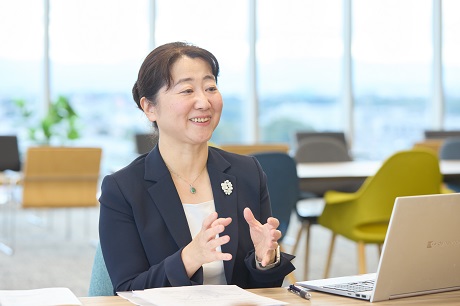
Claudia Goldin, who has been selected to receive the 2023 Nobel Prize in Economic Sciences (officially the Sveriges Riksbank Prize in Economic Sciences in Memory of Alfred Nobel), has been conducting research on women's work and gender wage gaps for a long time, mainly in the United States. She has stated that an increasing number of women want to have both a career and a family, and that the key to realizing this aspiration is flexibility in working styles.
In Japan, in the past few years, a number of laws related to work style reform have been enacted. When talking about work style reform, attention is often focused on the correction of long working hours, but in addition, various other reforms are being promoted, such as the elimination of unreasonable differences in treatment between regular and non-regular employment, the promotion of women's participation in the workforce, the promotion of employment for the elderly, and an increase in the minimum wage.
In the future, when a decrease in the number of people who can supply the labor force is inevitable, the bargaining power of workers will increase due to the balance between supply and demand in the labor market. We have no choice but to shift policies from an issue of "quantity" that emphasizes securing employment opportunities for many people to an issue of "quality" that emphasizes making workplaces attractive to workers and creating higher added value.
Facing a labor shortage, Japan is now facing a major paradigm shift, a transformation in ways of thinking and ideology that have been taken for granted up until now. Rather than negative factors such as economic contraction, I would like people to think that we are standing at the entrance to an economic environment in which everyone, including business owners, is required to work in ways that satisfy everyone and create new added value.
In Japan, in the past few years, a number of laws related to work style reform have been enacted. When talking about work style reform, attention is often focused on the correction of long working hours, but in addition, various other reforms are being promoted, such as the elimination of unreasonable differences in treatment between regular and non-regular employment, the promotion of women's participation in the workforce, the promotion of employment for the elderly, and an increase in the minimum wage.
In the future, when a decrease in the number of people who can supply the labor force is inevitable, the bargaining power of workers will increase due to the balance between supply and demand in the labor market. We have no choice but to shift policies from an issue of "quantity" that emphasizes securing employment opportunities for many people to an issue of "quality" that emphasizes making workplaces attractive to workers and creating higher added value.
Facing a labor shortage, Japan is now facing a major paradigm shift, a transformation in ways of thinking and ideology that have been taken for granted up until now. Rather than negative factors such as economic contraction, I would like people to think that we are standing at the entrance to an economic environment in which everyone, including business owners, is required to work in ways that satisfy everyone and create new added value.
Freedom to work
Towards a prosperous society with choices
Towards a prosperous society with choices
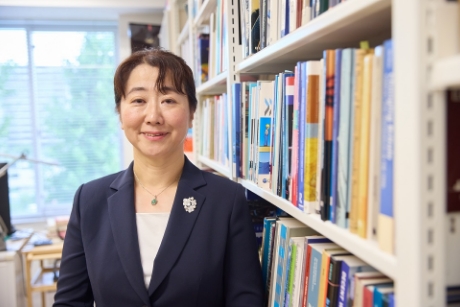
In relation to flexibility in working styles, I would like to talk about the "Dutch miracle."
The Netherlands is where I used to conduct Research Student, and due to historical reasons, it was once a strongly conservative country with a clear division of roles between men and women, with a higher proportion of full-time housewives than in Japan.
However, after the oil crisis, the country faced a serious economic crisis that was also known as the "Dutch disease," and the government and labor and management began to make major revisions to the working environment. By establishing laws that allowed flexible working styles and allowed full-time employees to work part-time, around 2000 the labor market had changed to one where people could work at their own will, adjusting the length of their working hours at their own pace at any stage of life, regardless of gender or age. As a result of creating a society where the so-called "freedom to choose working hours" was guaranteed, the economy made a major V-shaped recovery, and this time it was called the "Dutch miracle."
Furthermore, since the COVID-19 pandemic, remote work (telework) has become established in countries around the world. People around the world have realized that many more jobs can be done without coming into the office than they had thought.
In the Netherlands, there was already a movement to promote teleworking at the labor-management level in the early 2000s. In 2016, the right to apply for a change of place of work was also recognized. In 2022, after the COVID-19 pandemic, this right was strengthened to the right to change place of work, moving towards guaranteeing the "freedom of choice of place of work." I was surprised when I learned about the movement of labor and management to promote teleworking together about 20 years ago, but looking back now that we have experienced the COVID-19 pandemic worldwide, it seems fair to say that the country was at the forefront of a social trend.
In Japan, too, work style reforms are underway, and more and more companies are introducing systems that allow employees to choose when and where they work. We are now standing on the threshold of a labor-scarce society, and workers will likely have more bargaining power and greater freedom in how they work.
Of course, I think it is difficult to guarantee "freedom of choice of place of employment" in interpersonal services such as medical care and nursing care. However, when considering the future of this country, it is also important to take advantage of digital transformation and other methods to save manpower outside of the service sector and have more people engage in essential work that is essential to improving people's quality of life. This is one of the reasons why I specialize in both labor economics and social security.
Many young people, including our students, seem to be feeling anxious about the future of the Japanese economy. However, I would like them to see the positive side as well. Our society can move in a brighter direction little by little, depending on the economic situation, the voices of the people at any given time, and the efforts of companies and the government.
The labor-scarce society in which you will all be living is one in which I would like you all to learn and think about how to make it a more attractive society in which everyone can be cheerful and smile, and I would like to think about this together with you all.
The Netherlands is where I used to conduct Research Student, and due to historical reasons, it was once a strongly conservative country with a clear division of roles between men and women, with a higher proportion of full-time housewives than in Japan.
However, after the oil crisis, the country faced a serious economic crisis that was also known as the "Dutch disease," and the government and labor and management began to make major revisions to the working environment. By establishing laws that allowed flexible working styles and allowed full-time employees to work part-time, around 2000 the labor market had changed to one where people could work at their own will, adjusting the length of their working hours at their own pace at any stage of life, regardless of gender or age. As a result of creating a society where the so-called "freedom to choose working hours" was guaranteed, the economy made a major V-shaped recovery, and this time it was called the "Dutch miracle."
Furthermore, since the COVID-19 pandemic, remote work (telework) has become established in countries around the world. People around the world have realized that many more jobs can be done without coming into the office than they had thought.
In the Netherlands, there was already a movement to promote teleworking at the labor-management level in the early 2000s. In 2016, the right to apply for a change of place of work was also recognized. In 2022, after the COVID-19 pandemic, this right was strengthened to the right to change place of work, moving towards guaranteeing the "freedom of choice of place of work." I was surprised when I learned about the movement of labor and management to promote teleworking together about 20 years ago, but looking back now that we have experienced the COVID-19 pandemic worldwide, it seems fair to say that the country was at the forefront of a social trend.
In Japan, too, work style reforms are underway, and more and more companies are introducing systems that allow employees to choose when and where they work. We are now standing on the threshold of a labor-scarce society, and workers will likely have more bargaining power and greater freedom in how they work.
Of course, I think it is difficult to guarantee "freedom of choice of place of employment" in interpersonal services such as medical care and nursing care. However, when considering the future of this country, it is also important to take advantage of digital transformation and other methods to save manpower outside of the service sector and have more people engage in essential work that is essential to improving people's quality of life. This is one of the reasons why I specialize in both labor economics and social security.
Many young people, including our students, seem to be feeling anxious about the future of the Japanese economy. However, I would like them to see the positive side as well. Our society can move in a brighter direction little by little, depending on the economic situation, the voices of the people at any given time, and the efforts of companies and the government.
The labor-scarce society in which you will all be living is one in which I would like you all to learn and think about how to make it a more attractive society in which everyone can be cheerful and smile, and I would like to think about this together with you all.
Related Links
- Faculty of Economics TOP
- Faculty of Economics Department of Economics Department Introduction
- School of Economics and Business Department of Economics Four Years of Learning
- Faculty of Economics Department of Economics Course Introduction/Course Model
- Faculty Faculty of Economics Department of Economics /Special Lecture
- Faculty of Economics Department of Economics Seminar
- Faculty introduction of Faculty of Economics Department of Economics